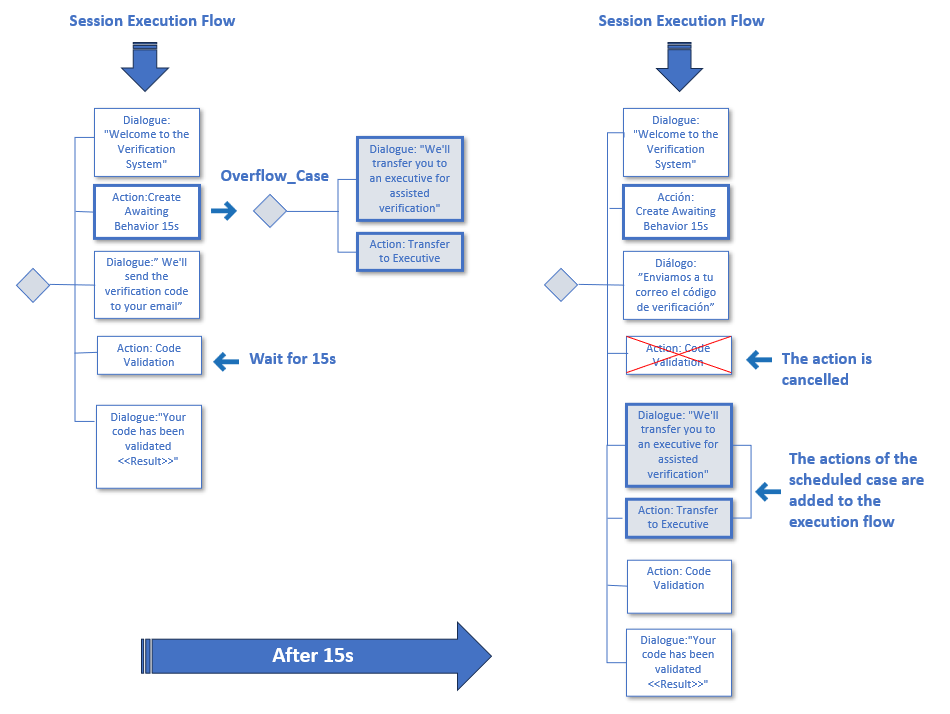Create Awaiting Behavior
Element Name: Create Awaiting Behavior
Category: Action Module (Time)
Description: Advanced functionality. It consists of a configurable dialog box with a customizable name.
Functionality: Allows executing a case within a specified time limit. This time is counted from the action's execution. The case execution can be Auto-Cancellable or not.
Important: Auto-Cancellable means that if the client writes any message, the scheduled execution of the configured case is canceled. If it's not auto-cancellable, the only way to cancel the case execution is by using the action: Cancel Awaiting Behavior.
Awaiting Behavior Action Configuration Fields
[Name]: Unique descriptor for the configuration box for identification purposes within the flow.
General Subset
[Time before executing the awaiting behavior]: Numeric field allowing selection from a dropdown list of the time before initiating the waiting period. The minimum allowed time is 5 seconds, and the maximum allowed time is 120 seconds.
[Case to execute as awaiting behavior]: In this field, the previously created case to execute during the waiting period is defined.
[Will awaiting behavior be canceled with user interaction]: Should contain a value of true if auto-cancellation of the scheduled case execution is desired. When it contains false, the only way to cancel the case execution is by using the action: Cancel Awaiting Behavior.
[Entity where the ID of the awaiting behavior is stored]: Defines an entity (previously created of type string) that will contain the ID identifying the ongoing awaiting behavior.
Create Awaiting Behavior Usage Restrictions
The creation of Awaiting Behavior and the execution of the associated Case are subject to the following constraints:
- Maximum of only one scheduled Awaiting Behavior. Attempting to create another Awaiting Behavior while one is still scheduled triggers an error that can be observed in the debug module and in the Log. This error does not interrupt the execution flow.
- Recursion restriction is present in the execution of programmed cases, limited to 10.
- It's not possible to create an Awaiting Behavior if the session is already marked for deletion. In this case, the action is ignored.
- It's not possible to create an Awaiting Behavior if the session is in chat mode, either in queue or connected with an executive. In this case, the action is ignored.
- If the execution of the programmed Case is triggered while the session is awaiting an entity, this entity is canceled and removed from the session to facilitate the continuity of the execution flow.
Awaiting Behavior Implementation Example
-- Input
-
[Time before executing the awaiting behavior]: 15
-
[Case to execute as awaiting behavior]: overflow_case
-
[Will awaiting behavior be canceled with user interaction]: true
-
[Entity where the ID of the awaiting behavior is stored]: IDthread
-- Outcome
Here is an illustration of a flow containing dialogue and actions. The action to which the Awaiting Behavior is applied is the insertion of a Verification Code within a maximum time of 15 seconds. It is configured as auto-cancellable; therefore, if the code is entered within the configured 15 seconds, it will continue with the next action, which is Code Validation. If the value is not entered, or it is entered after the 15 seconds, the flow will transfer to an Executive to assist in Code Validation.

- [Entity where the ID of the awaiting behavior is stored]: Identifier of Awaiting Behavior execution --> IDthread